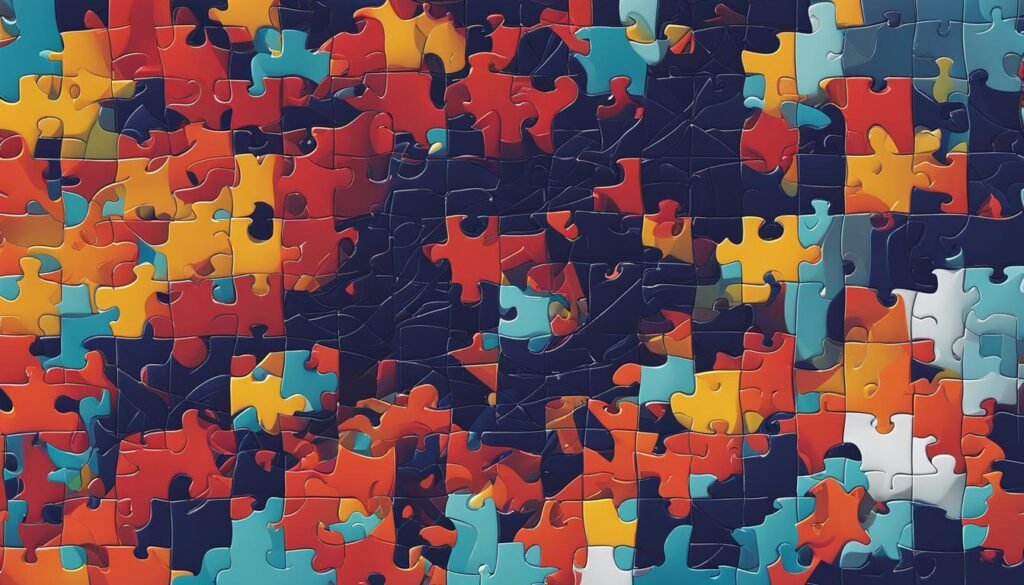
Unraveling the Artificial Intelligence 8 Puzzle Problem

Welcome to our exploration of the fascinating world of the artificial intelligence 8 puzzle problem. In this article, we will delve into the intricacies of solving this computational challenge using AI techniques. The 8 puzzle problem involves rearranging tiles on a 3x3 grid to reach a specific configuration, and artificial intelligence provides a powerful tool for solving it.
With the advancements in AI technology, we have witnessed remarkable progress in tackling complex problems like the 8 puzzle. By leveraging artificial intelligence, we can develop intelligent agents that can reason, learn, and make decisions in solving puzzles.
Key Takeaways
- Artificial intelligence is an essential tool for solving the 8 puzzle problem.
- AI techniques, such as NLP and machine learning, can be applied to optimize puzzle-solving algorithms.
- Natural Language Processing helps AI agents interpret and process the rules and constraints of the puzzle.
- Machine learning enables AI models to learn patterns and strategies from past puzzle solutions.
- By training AI agents on a large dataset, they can make informed decisions based on past experiences.
NLP and Artificial Intelligence for 8 Puzzle Problem
Natural Language Processing (NLP) plays a crucial role in optimizing AI algorithms for solving the 8 puzzle problem. By leveraging NLP techniques, we can enhance the AI agent's understanding of the puzzle rules and constraints, enabling it to reason about possible move sequences more effectively. With NLP, the AI can interpret human language instructions and translate them into actionable steps to solve the puzzle.
See Also... Exploring Artificial Intelligence: 8 Examples in Modern Use
Exploring Artificial Intelligence: 8 Examples in Modern UseOne of the key benefits of using NLP in the context of the 8 puzzle problem is the ability to process ambiguous instructions. In many cases, the instructions provided to solve the puzzle can be vague or imprecise. NLP algorithms can help the AI agent disambiguate these instructions and make more accurate interpretations.
Moreover, NLP enables the AI agent to gather information from various sources, such as online forums or puzzle-solving communities, to improve its performance. By analyzing discussions and strategies shared by puzzle enthusiasts, the AI can learn new techniques and approaches to solve the 8 puzzle problem more efficiently. This ability to gather and leverage external knowledge sets NLP-powered AI agents apart from purely rule-based solvers.
NLP Techniques for 8 Puzzle Problem
When it comes to NLP techniques used for optimizing AI algorithms for the 8 puzzle problem, there are several approaches that have shown promising results. One common technique is the use of natural language understanding (NLU) models, which help the AI agent comprehend the instructions provided by the user. These models can handle complex sentence structures, detect key phrases, and extract relevant information for puzzle-solving.
See Also... Exploring 80000 Hours in Artificial Intelligence Journey
Exploring 80000 Hours in Artificial Intelligence JourneyAnother useful NLP technique is sentiment analysis, which allows the AI agent to understand the emotions and intentions behind the user's instructions. By analyzing the sentiment, the AI can adapt its strategy to provide a more personalized and satisfactory puzzle-solving experience. This can be particularly helpful in scenarios where the user expresses frustration or requests hints.
Overall, the combination of NLP and artificial intelligence enhances the capabilities of AI agents in tackling the 8 puzzle problem. By bridging the gap between human language and AI reasoning, NLP techniques empower AI agents to interpret instructions accurately, gather external knowledge, and adapt their strategies based on user sentiment. These advancements contribute to more efficient and enjoyable puzzle-solving experiences for users.
https://www.youtube.com/watch?v=9liuWhfw2hs
See Also... Master Artificial Intelligence: Class 8 Study Guide & Tips
Master Artificial Intelligence: Class 8 Study Guide & TipsMachine Learning for Solving Puzzles Using AI
When it comes to solving puzzles using artificial intelligence, machine learning techniques have proven to be invaluable. By leveraging vast amounts of data, we can train AI models to understand and tackle complex problems such as the 8 puzzle problem.
Machine learning allows AI agents to learn from past experiences and make informed decisions. By analyzing a large dataset of puzzle solutions, these models can identify patterns and strategies that lead to successful outcomes. This empowers AI agents to approach the 8 puzzle problem with confidence and efficiency.
Artificial intelligence puzzle solving is no longer limited to deterministic algorithms. Through machine learning, AI agents can adapt and improve over time, constantly refining their problem-solving abilities. This opens up new possibilities for tackling challenging puzzles and finding innovative solutions.
As we continue to explore the potential of machine learning in puzzle solving, we are witnessing the emergence of AI agents that can rival human performance. The combination of artificial intelligence and machine learning is revolutionizing the way we approach complex problems, offering exciting prospects for the future of puzzle-solving technologies.
FAQ
What is the artificial intelligence 8 puzzle problem?
The artificial intelligence 8 puzzle problem involves solving a puzzle where eight tiles are arranged on a 3x3 grid. The goal is to rearrange the tiles from their initial positions to reach a specific configuration.
How does Natural Language Processing (NLP) help AI agents solve the 8 puzzle problem?
NLP techniques bridge the gap between human language and AI's understanding of the puzzle. They help AI agents interpret and process the rules and constraints of the puzzle, enabling them to reason about move sequences and select the most promising ones.
How does machine learning contribute to solving puzzles using AI?
Machine learning techniques are used to train AI models on a large dataset of puzzle solutions. By learning patterns and strategies from this data, the models can make informed decisions when approaching the 8 puzzle problem, based on past experiences.
If you want to know other articles similar to Unraveling the Artificial Intelligence 8 Puzzle Problem you can visit the Blog category.
Leave a Reply






Related Post...